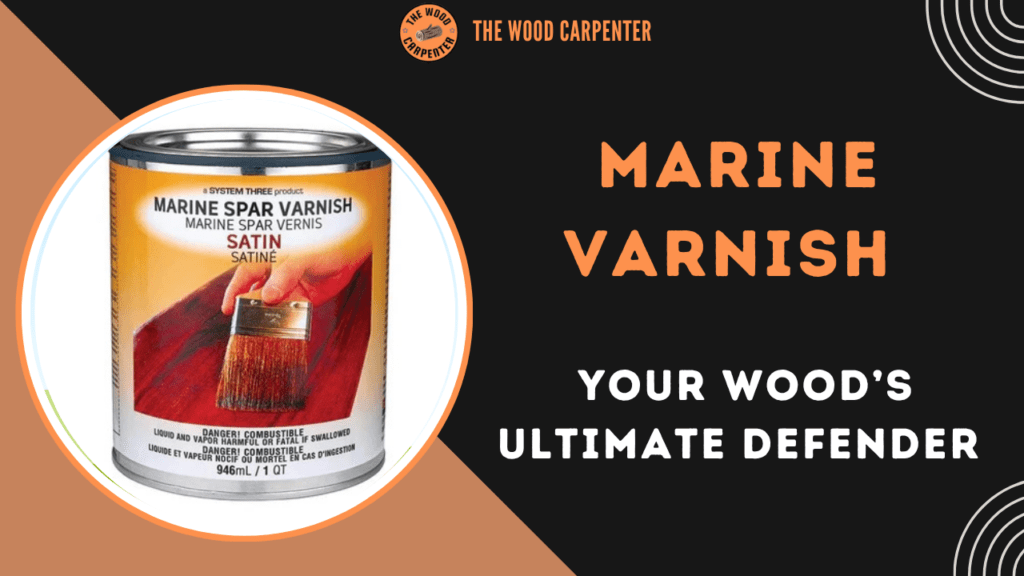
Marine varnish is one of the best ways to protect and make wooden surfaces look good, especially when they’re used outdoors or near water—like on boats, docks, garden furniture, or trim.
In this article, we’ll explain what marine varnish is, how it works, why it’s useful, how to apply it, how it’s different from regular varnish, and answer common questions for woodworkers, boat lovers, and anyone who enjoys outdoor wood projects.
What Is Marine Varnish?
Marine varnish is a special type of strong wood coating made to handle harsh weather, sunlight, and water. It was first used in shipbuilding to protect wooden parts from saltwater, sun damage, and cracking. It moves with the wood instead of breaking, so it lasts longer outdoors.
People commonly use marine varnish on:
- Boats and yachts (like the sides, decks, and railings)
- Docks and outside doors or trim
- Wooden outdoor furniture
- Canoes, kayaks, and garden decorations
Key Benefits of Marine Varnish
Great Water Protection: Keeps water out of the wood, stopping swelling, rot, and mold.
Sun Protection: Blocks harmful UV rays, helping to stop fading, yellowing, and sun damage.
Flexible & Durable: Moves with the wood as it expands and shrinks in changing weather, without cracking or peeling.
Looks Great: Makes the wood grain and color stand out, giving a smooth, professional finish.
Tough Protection: Resists salt, light chemicals, and scratches—perfect for boats and outdoor use.
What Is Marine Spar Varnish?
Marine spar varnish (also known as “boat varnish” or “yacht varnish”) is a traditional type of marine varnish. It was first made to protect the tall wooden poles (called spars) on sailboats. It’s known for being very flexible, strong against weather, and able to block UV rays from the sun.
Features of Marine Spar Varnish
What It’s Made Of: Older versions used lots of natural oil to keep the varnish flexible. Today’s versions may include polyurethane or alkyd resins with modern UV blockers for better protection.
Flexibility: Bends and stretches with the wood as it reacts to heat, cold, and moisture, so it doesn’t crack or split.
Beautiful Finish: Comes in glossy, satin, or matte styles. Adds a warm amber tone that makes wood look rich and natural.
How Does Marine Varnish Differ from Regular Varnish ?
| Property | Marine Varnish | Regular Varnish |
| UV Protection | High | Moderate/Low |
| Water Resistance | Superior | Moderate |
| Flexibility | Flexible | Tends to be brittle |
| Usage | Marine/outdoor | Indoor, mild outdoor |
| Durability (outdoor) | 2–5 years (with care) | 1–2 years (with care) |
| Application | Brush, roll, spray | Brush, roll |
| Finish Options | Gloss, satin, matte | Gloss, semi-gloss, matte |
| Re-coat Maintenance | Every 2–5 years | Usually every 1–2 years |
Also read:
How to Apply Marine Spar Varnish: Step-by-Step
Prep the Wood: Start with bare, clean wood. Sand it smooth using 120–150 grit sandpaper. Remove all dust, grease, and any old finish so the varnish sticks well.
First Coat Tip: Some people thin the first coat with 10–50% mineral spirits (check your product label). This helps the varnish soak into the wood better.
Apply Several Coats: Use 3 to 5 coats for the best protection. Let each coat dry fully before adding the next. Lightly sand between coats to help the new layer stick and to keep the surface smooth.
What Tools to Use: You can use a natural bristle brush, foam brush, roller, or spray—pick the one that gives you the smoothest finish for your project.
Let It Cure: After the final coat, let the varnish cure (fully dry and harden) for a few days before using the surface heavily or exposing it to the weather.
Finish Tip: If you want a satin or matte finish, use glossy varnish for the first few coats, then apply one final coat of satin or matte varnish at the end.
Marine Spar Varnish Maintenance
Routine Cleaning: Wipe with a damp, soft cloth; avoid abrasive cleaners.
Touch-ups: Sand and recoat as needed for worn areas or annual maintenance to ensure continuous protection.
Recoating: As the finish wears, sand the top layer lightly and add another coat of spar varnish.
Also read:
Stain vs. Varnish: Which Should You Use?
Varathane vs. Minwax: Which Wood Finish Brand Should You Choose?
Best Uses for Marine Varnish
Boats & Yachts: Protects wood exposed to constant wet/dry cycles and sunlight.
Outdoor Furniture: Seals and beautifies decks, benches, and garden accessories.
Doors & Trim: Keeps exterior doors, sills, and trim looking fresh and protected.
Musical Instruments: Sometimes used on wooden instrument parts for durability and tone preservation.
Top Tips for Success
- Never apply in direct sunlight or during very humid/rainy conditions.
- Stir, don’t shake, the varnish to avoid bubbles.
- Thin coats dry faster and reduce sagging/dripping.
- Choose products rated for above-water-line if submersion is not expected; use only marine-specific coatings for any submerged parts.
Marine Varnish (and Spar Varnish) FAQs
1. What’s the difference between marine varnish and spar varnish?
Marine varnish is a general term for finishes that protect wood from water and sunlight.
Spar varnish is a type of marine varnish made for ship masts (called spars). It’s very flexible and handles sun and weather well.
Today, people often use both terms to mean the same thing—a strong, weatherproof outdoor wood finish.
2. How long does marine spar varnish last?
If applied and maintained properly, it can last 2 to 5 years outside.
High-use areas might need a touch-up once a year.
3. Can I use marine varnish indoors?
Yes! It works well indoors too, especially in humid rooms like sunrooms or bathrooms.
It gives a tough and shiny finish.
4. How many coats should I apply?
Apply at least 3 to 5 coats.
More coats mean more shine, depth, and protection.
5. What’s the difference between spar varnish and polyurethane?
Spar varnish stays flexible—it moves with the wood, so it doesn’t crack outdoors.
Polyurethane is harder and better for indoor use but might crack or peel if used outside.
6. Is marine varnish food-safe?
No. Marine varnish has strong chemicals and is not safe for cutting boards or countertops.
Use food-safe finishes for those.
7. Can I apply it over old varnish?
Yes, but you must clean, sand, and dull the old finish before applying new varnish so it sticks well.
8. Will marine varnish change the wood color?
Most marine varnishes give a clear or slightly warm amber tone, making the wood grain pop.
Some may darken the wood slightly, especially oil-based ones.
9. How do I fix scratches or worn spots?
Just lightly sand, clean the surface, and apply a fresh coat. It blends well if prepped properly.
10. Are there eco-friendly options?
Yes! Some water-based marine varnishes have low VOCs (fewer fumes) and dry quickly, though they might not last as long as oil-based types.
Final Thoughts
Marine varnish—especially spar varnish—is one of the best ways to protect outdoor wood. It guards against sun, water, and weather and keeps wood looking beautiful for years.
With good prep, multiple coats, and regular care, it’s perfect for anything from boats and decks to garden benches and patio furniture.

